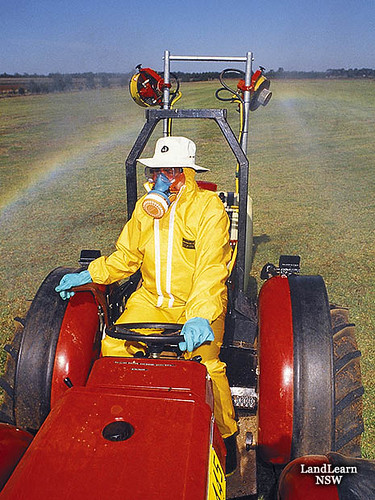EPA Worker Protection Standard Update
Written by: Sandra Menasha and Alice Wise
Originally published: Long Island Fruit and Vegetable Update, April 19th, 2018
The updated Worker Protection Standard took effect on January 2, 2017. The NYS DEC has the right to conduct inspections to certify that growers are in compliance with regulations for agricultural pesticides including organics. Inspections include WPS, record keeping, and pesticide storage.
The website http://www.pesticideresources…. has WPS information, the How to Comply Manual, Worker and Handler Training Videos (English and Spanish), the new WPS Safety Poster and useful WPS checklists. Alternatively, contact the Department of Environmental Conservation or your local Cooperative Extension office with questions.

This is a basic WPS checklist. We highly recommend checking the relevant section in the WPS How to Comply Manual as there are many additional details.
- All workers and handlers must receive annual training. Workers must be trained before they work in an area where a pesticide has been used or a restricted-entry interval (REI) has been in effect in the past 30 days. Handlers must be trained before performing any handler task.
- Training of workers and handlers can only be conducted by a certified pesticide applicator, State/Tribal/Federal approved trainers, or a person who has completed an EPA approved train-the-trainer course.
- Effective January 2018, training videos need to include the new content under the revised WPS. Videos (English and Spanish) can be found at www.pesticideresources.org. Keep records of all trainings for 2 years.
- Check your central posting area and make sure it is easily seen, accessible and the information posted is legible. The central posting area must have safety information (e.g. revised WPS safety poster), pesticide application information and pesticide Safety Data Sheets (SDS). Under the revised WPS, there is a new safety poster with updated safety information. Updated safety posters can be downloaded and ordered at pesticideresources.orgor ordered from Ag supply companies such as Gemplers.
- Information required at the central posting location should also be displayed at permanent decontamination supply sites or at locations with 11 or more workers.
- Pesticide application information and pesticide Safety Data Sheets (SDS) must be displayed at the central posting location within 24 hours of the end of the application and before workers enter the treated area. Display both for 30 days after the REI expires and keep on file for 2 years from the end of REI. SDS can be obtained from your pesticide supplier or from http://www.cdms.net/Label-Database.
- Pesticide Application information for WPS at the central posting area must include:
- crop treated, location and description of treated area(s),
- product name, EPA registration no., active ingredient(s),
- date and time pesticide application started and ended,
- and the restricted-entry interval (REI).
- A farm map is suggested for the central posting area so that workers can easily ID the location of all farm fields. Some growers use names (Main Road Chardonnay), some use numbers or letters (Field 2). The point being that if a DEC inspection occurs, your workers understand and are able to communicate the location of the applications and a farm map makes this easier.
- Check decontamination kits and upgrade as necessary:
- coveralls, soap and a stack of single use towels
- provide at least 1 gallon per worker using the site or 3 gallons for each pesticide handler and each early entry worker.
- one pint of water (eyewash) must be available to each handler applying pesticides if eye protection is required on the label. For tractor applications, the emergency eyewash water (1 pint) must be carried on the tractor. However, if the applicator gets off the tractor, the eyewash must be carried on their person. At mixing and loading sites, a system capable of delivering 0.4 gallons/minute for 15 minutes or 6 gallons of water to flow gently for 15 minutes must be provided for handlers using products requiring eye protection.
- check expiration date on eye flushing.
- decontamination kits must be within ¼ mile of all workers. Portable kits might be a better option for growers with a large operation.
- make sure all your handlers and workers know where the decontamination sites are and what they contain.
- The need for eye protection will be listed on the pesticide label in the box entitled “Agricultural Use Requirements”, in the section listing PPE (personal protective equipment).
- Refer to the “Agricultural Use Requirements” box on the pesticide label for a list of all required PPE. Make sure PPE is adequately stocked – chemical resistant suits, gloves, aprons, protective eyewear, boots, respirators and cartridges. Check unopened respirator cartridges for an expiration date.
- Where respirators are required on the pesticide label, handlers must be medically cleared to wear a respirator, receive annual respirator fit-testing and training. Records of completion of respirator fit-test, training and medical clearance must be kept for 2 years. Note: Owners of the agricultural establishment and family members are not exempt from the respirator requirements under WPS.
- respirators should be cleaned after each use and stored to protect them from damage, contamination and dust
- opened cartridges should be stored in a re-sealable plastic bag when not in use.
- Application Exclusion Zones (AEZ): There are several different requirements regarding the AEZ in the revised WPS. The size of an AEZ varies depending on the type of application and other factors, including droplet size, and height of nozzles above the planting medium. Refer to the How to Comply Manual to determine AEZ size.
- Effective January 2, 2017, agricultural employers are to not allow any workers or other persons in the AEZ within the boundaries of the establishment unl the application is complete.
- Effective January 2, 2018, handlers are to suspend the application if any workers or other persons are anywhere in the AEZ. This requirement is NOT limited to the boundaries of the establishment. This applies to any area on or off the establishment within the AEZ while the application is ongoing.
- Start accumulating copies of pesticide labels. All applicators must have a copy of the label immediately accessible. Some growers deal with individual labels, some put together a notebook to be carried on the tractor. Having a copy of pesticide label on your smart phone is not acceptable.
- When making an application, the applicator must have the following items immediately accessible:
- Applicator’s license
- Labels for all materials being applied.
- Appropriate PPE (see individual labels for what is required)
- Tidy up your pesticide storage area. A disorganized, messy storage area is a red flag to an inspector. Pesticide storage guidelines can be found at http://www.dec.ny.gov/regulations/8871.html.


